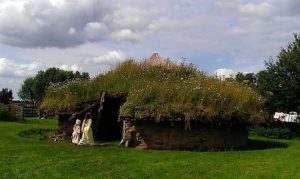
Must Farm is shedding light on Britain’s bronze age.
Above image is of the reconstructed Bronze Age roundhouse at [[Flag Fen]] in [[Cambridgeshire]], Eastern England. Photographed in July 2012 by: Midnightblueowl and shared at Wikimedia Commons.
Around 2 km south of Flag Fen is Must Farm Bronze Age settlement. Log boats recovered there are preserved and displayed at Flag Fen
Source: Wikipedia.org
At Must Farm, a new (2015) excavation in the Fenlands (low marshy areas) of Cambridgeshire, Great Britain, is said to possibly rival Pompeii, as an archaeological treasure, insofar as it offers a fairly complete view of a moment in time. While Italy’s city of Pompeii was preserved under volcanic ash spewing from Mt. Vesuvius, the two-to-five complete houses found in the Must Farm location of Cambridgeshire were preserved by the silt into which they collapsed, after a fire burned through their stilt foundations.
Pompeii’s burial under ash, in 79 A.D., was chronicled in rare written accounts of the day. The Must Farm stilt-houses’ burials, however, occurred during pre-history, leaving no written record. The bronze age homes are estimated to date back to 1000-600 B.C., with archeological excavation yielding the only clues to the occurrence and the articles found.
The account of this find from the BBC is brief, but gives an important overview for follow-up.
Archaeologists say they have uncovered Britain’s “Pompeii” after discovering the “best-preserved Bronze Age dwellings ever found” in the country.
The circular wooden houses, built on stilts, form part of a settlement at Must Farm quarry, in Cambridgeshire, and date to about 1000-800 BC.
A fire destroyed the posts, causing the houses to fall into a river where silt helped preserve the contents.
Pots with meals still inside have been found at the site.
In addition, archaeologists said “exotic” glass beads that formed part of a necklace “hinted at a sophistication not usually associated with the Bronze Age”.
Textiles made from plant fibres such as lime tree bark have also been unearthed.
However, the roundhouses themselves are now being excavated.
Archaeologists think they have found about five houses but are not yet certain.
The Bronze Age in Britain lasted from between 2500 and 2000BC until the use of iron became common, between 800-650BC.
It came after metalworkers discovered that adding tin to copper produced bronze, used for tools and weaponry which were much more hard-wearing.
The Greek poems of Homer – though composed later – look back to a time when bronze weapons were used.
In Britain, the Bronze Age lasted until about 800BC. Use of bronze seems to have coincided with fresh migration of people from the continent.
The article above refers to Homer, who composed his historical poems during the Greek “Archaic” age around 750 B.C. This was still considered a pre-historic, or pre-literary period, with Homer’s poems not being written down until a later time. The period of 750 B.C. appears to have been an early iron age following the collapse of the Greek bronze age.
You will find pictures of the Must Farm excavation, and the rest of this article, at bbc.com.
Visit the next page to read more about the physical conditions that helped to preserve the contents of these bronze age structures.



